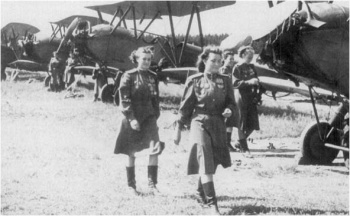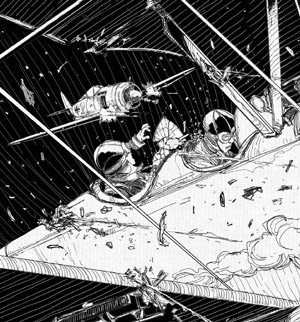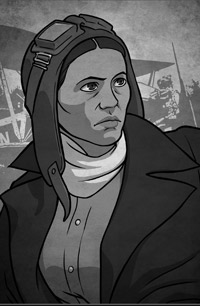 The Eastern Front, WW2. The USSR was on the back foot; the Red Army was badly unprepared, Stalin having purged its officer corps and ignored the threat of invasion. Nazi goals here were different: the English and French were honourable enemies, but Slavs were racially inferior, Communists were the scum of the earth, and this is where lebensraum was meant to happen. The war was desperate and brutal.
The Eastern Front, WW2. The USSR was on the back foot; the Red Army was badly unprepared, Stalin having purged its officer corps and ignored the threat of invasion. Nazi goals here were different: the English and French were honourable enemies, but Slavs were racially inferior, Communists were the scum of the earth, and this is where lebensraum was meant to happen. The war was desperate and brutal.
Desperate times called for desperate measures, and Marxism called for radical female equality. Soviet women joined the military, many of them in combat positions: snipers, tank drivers, pilots. But it shouldn’t come as a shock that Soviet institutions fell rather short of Marxist ideals: although the Party was delighted to use women fighters for propaganda, many struggled for acceptance.
 The only entirely female regiment was the 588th Night Bombers. Other women were flying shiny modern Yak-1 fighters and Pe-2 bombers, but the 588 got the Po-2, an outdated biplane more suited to flight training and crop-dusting. Their mission was low-priority: night harassment, bombing German positions to inflict stress and tie up resources, with little expectation of causing strategically significant damage. But the Po-2 was cheap to build and repair, and could be flown with relatively little training. (Night harassment proved so effective that the Germans eventually started copying it.)
The only entirely female regiment was the 588th Night Bombers. Other women were flying shiny modern Yak-1 fighters and Pe-2 bombers, but the 588 got the Po-2, an outdated biplane more suited to flight training and crop-dusting. Their mission was low-priority: night harassment, bombing German positions to inflict stress and tie up resources, with little expectation of causing strategically significant damage. But the Po-2 was cheap to build and repair, and could be flown with relatively little training. (Night harassment proved so effective that the Germans eventually started copying it.)
The Germans called them Nachthexen, night witches.
*
Jason Morningstar has a thing for RPGs about the ugly, brutal, little-known parts of history. His best-known game, Fiasco, is often played as a gonzo-dark comedy caper; there are more serious playsets for specific historical eras, but a lot of people neglect them, intimidated by a perceived expectation that they’ll know things about the setting. But Morningstar made his bones with Grey Ranks, a game about teenage partisans in the doomed Warsaw Uprising; his more recent work includes Carolina Death Crawl, about Southerners fighting for the Union in the US Civil War, and Durance, which recasts Australian prison colonies on hostile, distant planets.
Death Crawl, Grey Ranks and Night Witches, then, are games set in particularly brutal and desperate corners of war among combatants who don’t entirely fit in with their own side’s narrative or interests. The Warsaw Uprising was timed to link up with Soviet troops, but Stalin delayed the advance – a victorious Polish underground might have proved troublesome later. The Carolina Union boys were hated by their own neighbours and distrusted by their comrades; convenient for everyone if they died in the swamp. And in a society where standing out was extraordinarily risky, the Night Witches threatened gender norms and the military status quo.
When I talk to people about Night Witches, the thing that gets them excited is really the content, that it’s a carefully-researched historical game specifically focused on women in combat. It’s not a game that sells itself on its mechanics, exactly; it’s solidly-designed, but it doesn’t have the transformational, ground-breaking mechanics of a Fiasco or a Microscope. Indeed, it moves things towards more traditional territory in some respects; there’s a big pile of setting information you have to digest, and you are a team of warriors who go on quests and mostly work together. Novel content doesn’t guarantee a game that’s good to play, though – and content in games is most effective when it’s supported and elaborated upon by the mechanics. So I’m going to be talking about how this thing works.
(A big caveat: the game is best-suited for campaign play, and thus far I have only been able to play one-shots.)
*
Night Witches is a third-generation Apocalypse World descendant, drawing heavily on both AW and second-generation powered-by-the-Apocalypse games like Sagas of the Icelanders and Monsterhearts. The fundamental basis of ‘powered by the Apocalypse’ games is that they exist in worlds of desperate scarcity – emotional or physical – and feature flawed protagonists whose actions often make things worse.
The central mechanic of AW games is: every roll comes from a Move. Moves address the conflicts that the game centres around: if what you’re doing doesn’t really count as one of those kinds of conflict, you don’t roll. On the surface Moves look like ways to kick ass, but really they’re opportunities to get in trouble. Moves are game-verbs: they define the scope of normal action, and thus are central to what the game is really about.
The basic moves of Monsterhearts are a paradigm of game-verb design, both straightforward and deep, and articulating something significant when taken together. The subtext of the Monsterhearts action scope is: your teenage characters’ social dynamics are dysfunctional, self-centred, and treat people as objects, because that’s all you know; but only through fucking up can you grow into more mature, caring, respectful relationships.
The first obvious thing about Night Witches’ basic Moves is that they’re very much tied to a regular cycle of action. Moves are divided into Day Moves and Night Moves, which are quite different; by day you’re dealing with life on-base, by night you’re flying planes and getting shot at. Brief and Debrief, which trigger night and day, are also expressed as Moves (even though you don’t roll dice for them). Night-time follows a regular sequence, too: the lead navigator uses the Wayfind move to navigate to your mission objective, then the lead pilot uses Attack Run move to bomb it. This can provide useful momentum – if you don’t really know what scene to do next, it’s probably time to Brief – but it can also be a temptation to move things along too quickly, rather than giving scenes the development they deserve.
Most of the moves – all of the Night Moves, plus two of the Day ones – are specifically about the planes. Planes in Night Witches are meant to be characters. There are conditions which give planes a personality, and you can have Regard – important relationships – for planes as though they were people.
A lot of the social action of Moves is indirect. Do you assign an airwoman to the plane and seat she wants? Do you help find spare parts for the plane she damaged? Do you navigate your section safely to the target, or get them scattered and lost? This is a game with a pretty strong perspective about competence, about how it affects the people around you – but unlike many competence narratives, it’s very clearly divorced from meritocracy. Stolen credit is common, and you can easily get into really serious trouble for minor trespasses. Getting promoted or officially recognised has almost nothing to do with individual accomplishment. There are three ways you can Advance (leveling up, which includes promotion and medals): two of them are about survival rather than anything you did personally, and survival is as likely to result from someone else’s decisions as your own.
Many Day Moves are oriented towards the hierarchy. Acting Up is about pushing against your prescribed social role. Eyeball is often about understanding what’s going on in the power structure. Scrounging is all about whether you go through official channels or not. When you Tempt Fate by day, the thing you’re usually risking is official punishment. There’s a specific Move for when you get interviewed by the NKVD. Even though Day Moves represent more open, unstructured play than Night, they still reflect a regimented environment.
In fact, there is only one move designed for face-to-face social interaction that doesn’t typically invoke the hierarchy (Reach Out). In Monsterhearts that’s most of the Moves. This is an indication: in Monsterhearts most of the pressure comes from inside, with the desperation and emotional immaturity of the PCs and their peers fueling most of the drama. In plenty of Monsterhearts games, the external threats are a sideshow. But in Night Witches the pressure is overwhelmingly external: Stalin by day, Hitler by night.
Witches is designed to make player-character death normal, even inevitable; it’s meant to be unusual for a PC to survive through an entire campaign. If your character dies, or is out of the picture for a while (in hospital, in NKVD custody, lost behind enemy lines) you’re encouraged to take a turn in the GM’s seat, and to pick some new Threats to characterise your GM tenure. I haven’t yet had a chance to try this in practice, but I’m excited about it.
Night Narratives Are Difficult
Military aircraft stories used to be huge, reaching a peak around the generation for whom the Battle of Britain was recent history. They receded over the course of the Cold War, as technology made air combat less dramatic, and the only vaguely symmetric wars remaining were dominated by nukes. (Does anybody remember any of the actual dogfighting stuff in Top Gun? Or what it was meant to be about?)
 Where people do have a dramatic vocabulary about planes, it’s mostly about fighter planes. The only movies I can think of off-hand that feature bomber crews to any major extent are The Dambusters and Dr. Strangelove. And if you do have bomber stories, it’s probably about long-range strategic bombing – load up on bombs in your Lancaster or Flying Fortress, fly to a distant factory or bridge or whatever, bomb it, make the long, dangerous journey home, go to bed. Short-range harassment bombing was totally different; and even if you know that, you may not have a good sense of how that works as a story.
Where people do have a dramatic vocabulary about planes, it’s mostly about fighter planes. The only movies I can think of off-hand that feature bomber crews to any major extent are The Dambusters and Dr. Strangelove. And if you do have bomber stories, it’s probably about long-range strategic bombing – load up on bombs in your Lancaster or Flying Fortress, fly to a distant factory or bridge or whatever, bomb it, make the long, dangerous journey home, go to bed. Short-range harassment bombing was totally different; and even if you know that, you may not have a good sense of how that works as a story.
So the biggest difficulty of Night Witches (for me, thus far) is about familiarity. Familiarity is really important to storygames: without having a strong feeling for a setting, it’s hard to creatively operate within it. Often storygames rely heavily on genre to provide this familiarity – which can limit your ability to tell unconventional stories, but does mean that you can get started quickly in the assurance that everyone basically understands the terrain. In Night Witches you can’t do that. If we were playing a campaign, I’d hope (maybe not expect) every player to have read through the book, and probably to do some light Internet research besides; in the one-shots I’ve run, you teach as you go along, but I think some players still felt ungrounded – teach-as-you-go isn’t a great method for providing context, in particular.
Aside from narrative-pattern stuff, there are straightforward accuracy issues. When you’re playing a historical scenario, people tend to feel more pressure to get things right. Players came up with a number of questions which I didn’t have answers for. “Where’s the fuel tank on a Po-2? Fuselage, yes, but where?” “Do Stukas have machine-guns, or cannons? What exactly is the difference?” Normally in a storygame the answer would be “make something up and stick with it,” but in a scenario that’s so historically specific, and for which a ton of research has plainly been done, people are less likely to feel comfortable with that. Several times people yanked out smartphones to look things up – never a good thing for engaged play. I suspect that this would simmer down over the course of a full campaign.
The two issues overlap most conspicuously when you ask players to do creative work filling in the world: the two questions which gave players the most pause were about their social and family background and “what unreasonable demand has been made of the Regiment?” – because in both cases they weren’t sure about scope, of what was normal and what was plausible.
Another tricky element: Night Witches mentions the possibility of playing Soviets of non-Russian ethnicity, to the point of including a few non-Russian names in the basic options; but it gives little specific guidance for this. (The back of the book has a lot of potted summaries of useful historical context, but this was probably way too broad a subject to condense.) In a campaign setting, you could go off and do your research; in a one-shot you have to rely on what you already know, which might very well be nothing. I had one player who had some pre-existing historical knowledge play a Ukrainian character who had lost family to the Holodomor; I had another who unwittingly picked an unmistakably Jewish name, then opted to change it rather than tackle a bunch of issues that they didn’t feel equipped for.
I think it’d be useful to develop a set of pre-rolled cards or tables: maybe a mix-and-match set, one for your family background (or maybe break it up by ethnicity, region, social position), one for how you came to be flying. (Picking randomly might be OK, but I think it’d be more useful just to give an impression of the range of possibility.) That said, Witches is already awash with handouts and cheat-sheets and cards – enough of them that they’re a little troublesome for a GM to juggle.
(Physically, Night Witches is a really nice book: clearly laid out, strongly illustrated, with evidence of dedicated research. My only gripe is that it can be a little tricky to look up certain things mid-game, partly because there’s more info than can be condensed into a single cheat-sheet. Players were all grumbly about the vagueness with which their special Role bonuses were described on the character sheet, and I found myself thumbing back and forth looking up Special Moves more than I expected.)
 Dang That’s A Lot Of Campaign
Dang That’s A Lot Of Campaign
Night Witches is a really grabby concept, but actually playing a full campaign is a tough sell. A lot of folks are super-enthusiastic about the game, but thus far, I’ve only been able to get one-shots together. A good many people in the storygames space have no interest in playing in settings featuring historical sexism and homophobia, and that’s kind of a central pillar of Night Witches – probably some folks get initially excited by Women Kicking Ass, then realise they may not want to play Women Getting Destroyed By An Incredibly Oppressive System (and this is definitely a game about both). The historical aspect, again, creates a sense of unease about familiarity. And powered-by-the-Apocalypse games tend to go dark enough that you wouldn’t want to be in a campaign with just anybody; you need to pick players you can trust.
A full Witches campaign is pretty long, at least by storygame standards. The campaign follows the historical campaigns of the 588th, from basic training to the capture of Berlin; a total of seven duty stations. Three of those are half-sized, so that’s a total of 39 day/night cycles. That can be shortened by taking the Moving On advance – let’s say you have four players, they all take Moving On once, each dodging an average of three missions – that seems like a pretty hefty reduction, but still leaves 27 cycles.
In the sessions I’ve run, three hours and change was enough for character creation plus two day/night cycles. So, say an hour for a cycle – you’d get more efficient later on in the process, but you’d also hit more in-depth character-driven scenes – you’re looking at a campaign of maybe 10-14 sessions. (The East Coast storygames scene that Morningstar hails from has a reputation for running games fast – certainly, every game of his that I’ve seen has overrun its time-to-teach-and-play estimate by substantial margins.) That’s pretty normal by trad RPG standards, but it has proven a difficult thing to ask of storygamers: even though I have played storygame campaigns that long, they never started out with that expectation.
Anyway. Play Night Witches with me. It’s got its challenges but it’s really freaking cool.


Fascinating. Thanks for the write-up.
Nice review! Coming off reading Elizabeth Wein’s WW2 books (about Allied women pilots among other things) this sounds great.
Very interesting review. I note, however, that the apparent omission of one word makes it particularly scary: “Witches is designed to make player death normal, even inevitable…” ^_^
For other war movies based on bombers, see “Twelve O’Clock High” (1949), “The Purple Plain” (1954), “Memphis Belle” (1990); and several WWII-time productions (“Dive Bomber,” “Target for Tonight,” “One of Our Aircraft is Missing,” Johnny in the Clouds”).
Thanks for the catch!
Thanks for the thoughtful review!
Regarding your concern about the length of a campaign, remember that one of the GM Principles is “Sometimes just give it to them”. I occasionally use this as GM (or suggest it as player) to say “OK, the mission goes uneventfully, you’ve returned and debriefed, what now?” This is particularly useful when there is a lot of interpersonal drama that really needs resolution, and the night missions are not adding much pressure to that. Sometimes the opposite is true, but it is totally OK to skip missions in the fiction, which will speed up the game. If you skip a mission with special rewards, which I do not recommend, make sure to award them anyway.
It is also totally legit to skip training and Duty Station 1, or to pick up play later in the war after skipping a Duty Station or two. This impacts character growth (net loss) and survivability (net gain) but it won’t mess anything up too bad.
Thanks again!
But I really like the idea of starting out in training! I mean, probably my complaint mostly boils down to the fact that I want the game as written, but social organisation is hard.
Oh hey, another media resource I just learned about: Ночные Ласточки, a Russian miniseries about the Night Witches (well, the “Night Swallows” anyway)…
Aha! I had found that online already, but somehow not in a version with subtitles, which rather limited its usefulness. Thanks!
Pingback: Diadem | These Heterogenous Tasks